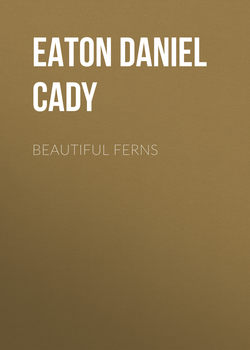Читать книгу Beautiful Ferns - Eaton Daniel Cady - Страница 2
ONOCLEA STRUTHIOPTERIS, Hoffmann.
Ostrich-Fern
ОглавлениеOnoclea Struthiopteris: – Caudex short, thick, erect, emitting slender subterranean stolons; stalks stout, a few inches to a foot long, chaffy at the base; fronds standing in a vase-like crown, dimorphous; sterile ones one to ten feet high, herbaceo-membranaceous, broadly lanceolate, narrowed from the middle to the base, abruptly short-acuminate, pinnate; pinnæ very many, sessile, the lowest ones sinuate and deflexed, the rest three to eight inches long, five to nine lines wide, linear-lanceolate, acuminate, deeply pinnatifid into numerous close-placed oblong obtuse entire segments provided with a midvein and several simple veinlets on each side; fertile fronds in the middle of the crown or vase, much shorter than the sterile, rigid, contracted, narrowed at the base, pinnate; pinnæ one to two inches long, crowded, obliquely ascending, linear, obtuse, sub-entire or pinnately lobed, the lobes one or two lines long and broad, the margins much recurved, and the whole pinna forming a somewhat articulated pod-like body; veinlets of the fertile segments few, soriferous on the back; receptacle elevated; indusium very delicate, lacerate-toothed, half surrounding the sorus; sporangia at length confluent and filling the fertile pinnæ.
Onoclea Struthiopteris, Hoffmann, “Deutschlands Flora, p. 11 (1795).” – Swartz, Syn. Fil., p. 111. – Weber & Mohr, Taschenbuch, p. 47, t. iv., f. 3, 4. – Schkuhr, Krypt. Gew., p. 97, t. 105. – Mettenius, Fil. Hort. Lips., p. 97, t. xvii., f. 11-15. – Milde, Fil. Eur. et Atlant., p. 154.
Onoclea nodulosa, Schkuhr, Krypt. Gew., p. 97, t. 104 (Perhaps also of Michaux, but this is still uncertain).
Onoclea Germanica, Hooker, Sp. Fil., iv., p. 161. – Hooker & Baker, Syn. Fil., p. 46.
Osmunda Struthiopteris, Linnæus, Sp. Pl., p. 1522.
Struthiopteris Germanica, Willdenow, “Enum, p. 1071;” Sp. Pl., v., p. 288. – Link, Fil. Hort. Berol., p. 38. – Hooker, Fl. Bor. – Am., ii., p. 262. – Torrey, Fl. New York, ii., p. 486. – Gray, Manual, ed. i., p. 623, etc. – Koch, Syn. Fl. Germ. et Helv., ed. iii., p. 739. – Williamson, Fern-Etchings, t. 44.
Struthiopteris Pennsylvanica, Willdenow, Sp. Pl., v., p. 289. – Pursh, Fl. Am. Sept., ii., p. 266. – Torrey, Compendium, p. 385. – Bigelow, Fl. Boston., ed. iii., p. 421.
Struthiopteris, the genus only, Willdenow, in Berl. Mag., 1809, p. 160.
Hab. – Low grounds, especially in fine alluvial soil subject to the overflow of rivers; from the Saskatchewan and Lake Winnipeg to New Brunswick, and southward to Pennsylvania and Illinois. Mentioned by Alexander Braun as coming from Arkansas. From Lapland to Sicily, and eastward to the Amoor region, Sachalin and Kamtschatka. Not known in the western parts of either Europe or America.
Description: – The ostrich-fern is one of our finest ferns, being surpassed in grandeur only by Acrostichum aureum, Woodwardia radicans, and perhaps Osmunda regalis. The plant is propagated chiefly by long and slender stolons, bearing appressed rudimentary stalk-bases. These stolons are said by Sachs to originate from buds formed on the stalks near the base: they run underground for several inches or a foot, and at the end rise to the surface and there thicken into a short erect caudex, covered by imbricating stalk-bases, and throwing up from the apex a grand vase-like circle of foliage, which is often higher than a man’s head, and sometimes extends above his utmost reach.
The stalks are seldom over a foot long: they are flattened, blackish, and chaffy at the base, but above ground they are green, drying dull-brown, somewhat four-sided, and deeply channelled in front, when dried furrowed on the sides also. They contain two flattened fibro-vascular bundles. The stalks of the sterile fronds are rather longer than the others, but more rigid, and remain erect till the second year.
The sterile fronds are oblong-lanceolate in outline, gradually narrowed to the base from near the middle and abruptly short acuminate. The pinnæ are usually of nearly equal breadth from the base to beyond the middle. They are pinnatifid to within a line of the midrib into numerous oblong and obtuse segments, the veins of which are free, simple and pinnately arranged on a midvein.
The fertile fronds are produced late in the summer, and are contracted, much shorter than the others, and very rigid. The pinnæ are sometimes nearly entire, and in other examples pinnately lobed. The margins are very much recurved, so that the pinnæ are pod-like, and either sub-cylindrical or somewhat moniliform. The venation is free, and the sori are dorsal on the veins. Mr. Faxon writes: “The indusium can be detected only when the fertile frond is very young, and appears as a very delicate, lacerate membrane, attached at the base of the receptacle, and serving to separate the sorus from its neighbors. I have not found it in any case hood-like as in O. sensibilis. The sori are quickly confluent, and all trace of the indusium is soon lost. The membranaceous edge of the transformed fertile pinna is attached near the bases of the inferior sori and a fold is usually found pressed against the sori as seen in the drawing (Fig. 3). This is usually ruptured, so as to leave a portion attached at the base of the sorus, and must not be mistaken for the true indusium, which is within.”
The sporangia have twenty-six or twenty-eight articulations of the ring. The spores are dark-colored and ovoid.
Imperfectly fertile fronds are often found, which are analogous to the “obtusilobata” condition of O. sensibilis.
